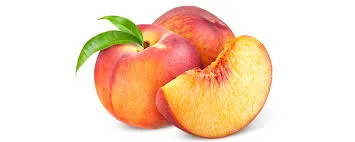Can a Dog Eat Peaches? Important Insight About the Risks and Benefits
As a dog owner, One fruit that might cross your mind is the peach. This juicy, sweet treat is a summer favorite for many, but can a dog eat peaches without any issues? In this article, we will delve into the nutritional aspects of it, the potential risks of feeding them to dogs, and how to safely introduce this fruit into your pet’s diet.

What Are Peaches?
word come from (Prunus persica) are stone fruits that belong to the genus Prunus, which includes other fruits like plums, cherries, and apricots. Known for their sweet and juicy flesh, peaches are a rich source of vitamins, minerals, and antioxidants, making them a popular choice for healthy snacks.
Nutritional Benefits
Peaches offer several nutritional benefits that can be advantageous for humans. Here’s a brief overview of their nutritional profile:
- Vitamins: Peaches are an excellent source of vitamins A and C. Vitamin A is important for vision and immune function, while vitamin C acts as an antioxidant and helps in collagen production.
- Fiber: Peaches contain dietary fiber, which aids in digestion and helps maintain a healthy gut.
- Antioxidants: The antioxidants in peaches, including phenolic compounds, can help combat oxidative stress and inflammation in the body.
Can Dogs Eat Peaches?
The answer is yes, but with certain precautions. While peaches are not toxic to dogs, there are important factors to consider when deciding to share this fruit with your furry companion.
1. Remove the Pit
One of the primary concerns with feeding peaches to dogs is the pit (or stone) found in the center of the fruit. The pit poses several risks:
- Choking Hazard: The peach pit can be a choking hazard, especially for small dogs. It’s crucial to ensure that the pit is entirely removed before offering any peach slices to your dog.
- Cyanide Content: Peach pits contain amygdalin, which can release cyanide when metabolized. While a single pit may not cause immediate harm, it’s best to avoid giving your dog any part of the pit.
2. Digestive Issues
Feeding your dog too many peaches can lead to digestive problems. If introduced in excessive amounts, the fiber content may cause:
- Vomiting
- Diarrhea
- Abdominal discomfort
To minimize the risk of digestive upset, it’s essential to introduce peaches gradually and in moderation.
3. Sugar Content
They are naturally sweet and contain sugars. While the sugar found in fruits is not harmful in small amounts, overindulgence can lead to:
- Weight Gain: Consuming too many sugary foods can contribute to obesity, particularly in less active dogs.
- Blood Sugar Spikes: Dogs with diabetes or other metabolic conditions should avoid high-sugar foods to prevent fluctuations in blood sugar levels.
4. Allergic Reactions
Though rare, some dogs may have allergies or sensitivities to peaches. Signs of an allergic reaction can include:
- Itching or skin irritations
- Swelling around the face or ears
- Gastrointestinal distress
If you notice any of these symptoms after your dog consumes peaches, it’s crucial to consult your veterinarian.
How to Safely Introduce Peaches to Your Dog
If you decide to share peaches with your dog, it’s essential to do so safely. Here are some steps to follow:
- Wash the Fruit: Always wash the peach thoroughly to remove any pesticides or chemicals that may be present on the skin.
- Remove the Pit: Make sure to remove the pit completely and discard it before offering any pieces of the peach to your dog.
- Start Small: Introduce peaches in small amounts to see how your dog reacts. A few small slices are a good starting point.
- Monitor Your Dog: Keep an eye on your dog for any signs of digestive upset or allergic reactions after eating peaches.
- Consult Your Veterinarian: If you have any concerns about feeding peaches to your dog, consult your veterinarian for personalized advice.
What to Do If Your Dog Eats a Peach Pit
If your dog accidentally consumes a peach pit, here are the steps to take:
- Stay Calm: While it can be alarming, many dogs can pass a pit without any problems.
- Monitor for Symptoms: Watch for signs of choking, digestive upset, or unusual behavior. Symptoms to look out for include vomiting, lethargy, or difficulty breathing.
- Consult Your Veterinarian: If your dog shows any concerning symptoms or if you are unsure about the amount consumed, contact your veterinarian for guidance.
Safe Alternatives
If you’re looking for dog-friendly fruits that are safer than peaches, consider these alternatives:
1. Blueberries
Blueberries are small, nutritious, and safe for dogs. They are rich in antioxidants and vitamins, making them a great snack.
2. Apples
Apples can be a crunchy and delicious treat for dogs. Just be sure to remove the seeds and core, as the seeds contain cyanide.
3. Bananas
Bananas are a low-calorie fruit that many dogs enjoy. They provide potassium and vitamin C and can be fed in moderation.
4. Carrots
Carrots are a crunchy and healthy snack that can help keep your dog’s teeth clean. They are low in calories and high in fiber.
5. Watermelon
Seedless watermelon is hydrating and offers vitamins A and C. Just make sure to remove any seeds and rind before sharing it with your dog.
Conclusion: Can a Dog Eat Peaches?
In conclusion, while dogs can safely eat peaches in moderation, it’s crucial to take certain precautions. Always remove the pit, introduce peaches gradually, and monitor your dog for any adverse reactions. By understanding the potential risks and benefits of feeding peaches to dogs, you can make informed decisions about your pet’s diet.
As always, prioritize your dog’s health and well-being. Consult your veterinarian for personalized dietary advice, and consider offering safer fruit alternatives to keep your furry friend happy and healthy. With the right knowledge, you can ensure that your dog enjoys a varied and nutritious diet that supports their overall health.
